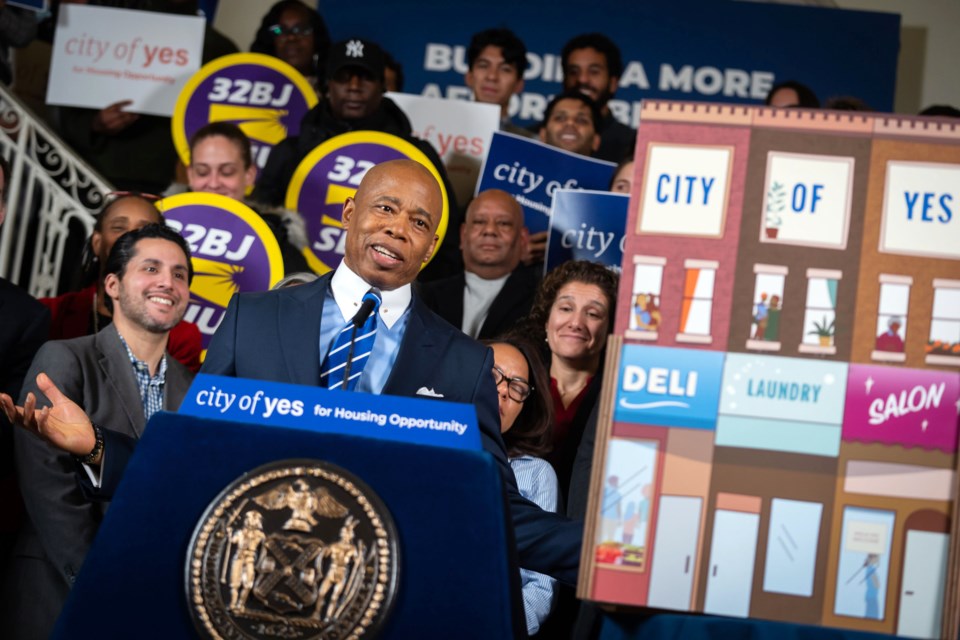The New York City Council on Thursday passed a housing plan that will create more than 80,000 new homes over the next 15 years.
New York City Mayor Eric Adams, New York State Governor Kathy Hochul, New York City Council Speaker Adrienne Adams and New York City Department of City Planning Director and City Planning Commission Chair Dan Garodnick celebrated the passage of “City of Yes for Housing Opportunity,” a pro-housing proposal that changes the city's zoning laws, allowing for builders to create more housing. The plan also comes with a $5 billion commitment for infrastructure upgrades, according to a press release.
“Today is a historic day in New York City, but, more importantly, for working-class New Yorkers. We showed the nation that government can still be bold and brave by passing the most pro-housing piece of legislation in city history. Our administration proposed and fought hard for this proposal for more than year, and now New Yorkers are the ones who will benefit from lower rent,” the mayor said.
The housing plan is necessary as the city battles high rent amid a historic low 1.4% vacancy rate, City Hall leaders said. However, after the mayor announced the proposal in June 2022, many communities fought against the plan, including residents in eastern Queens, Brooklyn and Staten Island. The City Council passed the plan with a 31-20 vote.
Highlights of the plan include:
- Creating the Universal Affordability Preference (UAP), allowing roughly 20% more housing in medium- and high-density developments, as long as the additional homes are permanently affordable. If UAP had been in place since 2014, an additional 20,000 income-restricted homes could have been created.
- Legalizing small accessory dwelling units for one- and two-family homes, with some restrictions in limited areas to address concerns around flooding and neighborhood context. These small homes, which include backyard cottages and converted garages, can give homeowners extra income and allow families to age in place.
- Permitting transit-oriented development and Town Center zoning, to create three-, four-, and five-story apartment buildings near most transit and along commercial corridors, respectively, with an affordability incentive for projects with more than roughly 50 homes.
- Allowing height-limited, contextual development on large campuses or lots, including those owned by faith-based organizations, that previously could not use their existing development rights because of outdated and conflicting rules.
- Rolling back parking mandates for new residential construction through a three-zone system that lifts them entirely in Zone 1, reduces them in Zone 2, and keeps them in place in Zone 3.
- Enacting new high-density zoning districts that would allow more housing, including mandatory affordable housing in high-demand central areas where it is urgently needed.
- Re-legalizing small and shared housing models with common facilities like kitchens.
- Making it easier to convert offices and other non-residential buildings into housing.
“By taking a major step to address the housing shortage, while supporting existing homeowners and tenants, making housing more affordable, expanding homeownership opportunities, and strengthening the infrastructure of neighborhoods, we are advancing a safer and stronger city," said City Council Speaker Adams. "This shows that our city can ensure every area helps contribute to confronting the housing crisis by creating more housing, while respecting the differences of neighborhoods across the five boroughs and investing in New Yorkers.”
Public Advocate Jumaane Williams applauded the passage of the plan, but said more needs to be done.
“The housing and homelessness crisis impacts New Yorkers across our city, and every community must be a part of combatting it. With today’s vote and the months of negotiations that preceded it, the City Council has taken a significant step forward to increase housing production, and should be applauded," Williams said. "At the same time, we cannot simply build our way out of the affordability crisis. Today’s plan, and the City for All investments paired with it, must be part of an overall strategy that includes preservation, voucher expansion, tenant protections, and more."




